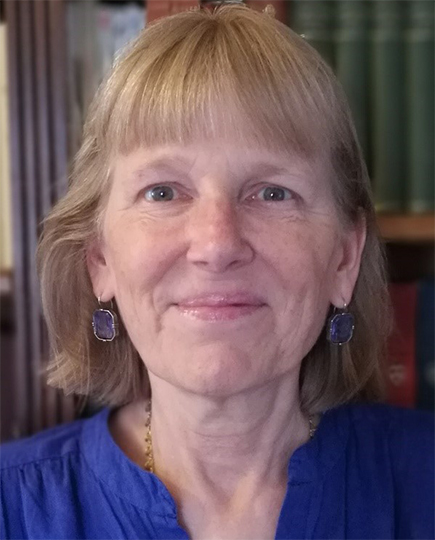Octobre 2019
Entretien
Spotlight on… Mathilde Fontanet

See the original interview in French
Mathilde Fontanet is an associate professor at the Faculty of Translation and Interpreting. In mid-July, she became co-head of the Translation Department and head of the French Unit. After initially pursuing studies in the Arts, Mathilde obtained a degree from ETI (the FTI’s predecessor), then worked for nearly two decades as a translator at CERN. It was during that time that she began to teach translation and carry out research in translation studies.
How did you come to work in the field of translation?
I really enjoyed studying English and German literature, but having to constantly speak and write in foreign languages was a little exasperating for me. Getting into translation was like coming back home – a return to my native language. I had the assurance of knowing that I would be able to find the words and nuances I was looking for.
What else do you like about being a translator, besides being able to work in your mother tongue?
Among many things, the usefulness of it. Human communication is complex. If we’re not precise enough, it can cost us dearly. If we send an email out too quickly, it can lead to a series of misunderstandings. We already have difficulty expressing ourselves clearly in our native languages, so when it comes to a foreign language, it’s better to leave it to the experts. Translating means being able to identify precisely what it is you need to communicate – sometimes in spite of the words – and presenting it to your audience in the most suitable form. You need to not only communicate information, but also handle this relationship, which makes it a very noble activity.
We sometimes run into the most unlikely problems, and there are these moments of joy when we find the perfect solution. We don’t often have an audience to cheer us on, but these little “strokes of genius” bring us a form of elation.
When I moved into research, I also discovered exciting new prospects. I was able to probe into more fundamental issues by attending conferences and reading the high-quality work of other researchers, as well as writing my own articles.
You carry out research in both technical and scientific translation, as well as literary translation. Are these two fields not diametrically opposed?
Perhaps. Research in the field of technical translation is more focused on practical aspects like how to handle challenges, teaching and terminology. But scientific translation also involves cultural elements and provides for a wider range of reflection, thanks to its demonstrative nature. Scientific popularisation is a very interesting topic. There are multiple issues at hand, and we can look at it from both a didactic and rhetorical perspective. However, it is literary translation that I find the most rich and fascinating because you can analyse a text in terms of cultural elements, intertextuality and a multitude of formal features.
Deciding how to translate cultural references in the text source can sometimes be a real dilemma. Certain cultural elements (called realia) are unique to the source culture and don’t have a counterpart in the target culture. There may also be an incompatibility between the two cultures. For example, I once translated a text in which the author falls into a deep nostalgia while conjuring up a stew of fish heads and kid goat meat from her native Liberia. Palm oil is also evoked in a very sensual manner and is presented as a delicacy that is both unctuous and savoury. How could I make these dishes appealing to the reader? How could I ward off any negative reactions that may stem from long-established associations and traditions? Translation studies allows us to delve into these questions by taking a step back and putting things into perspective.
I recently published an article that attempts to demonstrate that the notions of implied reader (defined by Wolfgang Iser in 1976), presumed reader and real reader can be used to describe the cultural adjustments that take place in translation. In the original, we can always find clues as to the skills and knowledge we need to understand that text. These are the qualities that are expected of the implied reader. I believe that when reading the original, the translator instinctively measures the gap between the encyclopedic knowledge of the implied reader and the presumed reader of the translation, and will make adjustments accordingly.
The voice that arises from a text is another subject that intrigues me. Whether we are reading a short story, novel or article, we perceive a voice that resonates from it. But how does that voice come into being? And what is its echo in translation?
The translation process also falls into your research interests. What can you tell us about this topic?
A number of theorists have reflected on the steps involved in this process. According to the interpretive theory from the Paris School, there are three phases: the reception of meaning (whether explicit or not) in the source language, the deverbalisation and the reproduction of it in the target language. On the other hand, there are theorists like Christiane Nord, who insists that the process is not linear and has developed a much more complex model. Like Nord, I am not sure that there is a clear phase of deverbalisation, which would enable us to go beyond language to get to the essence of a text. Instead, I would conceive of it as a great maelstrom in which all the different components are attuned to each other: elements from the source text, images associated with these elements, preconceived notions on the text and author, words from the source language and target language (or a third language), and an aureola of associations that we will never veritably be able to master. At the same time, there is a very effective filtering process that leads us to reject all kinds of solutions that may come to mind.
There is talk of using machine translation in the literary field. How do you feel about these developments?
I spoke to you about voice. When we’re reading a literary work, we’re not only dealing with the words and the form. We are accompanied by the “author”, even if it is simply a reconstruction that we unconsciously carry out based on the text. We are in communion with a subtle, coherent presence that inhabits the work and can implicitly be perceived everywhere. It is what nourishes the soul. Machine translation can, of course, provide us with a preliminary version that can be reworked. And yet, even if the words, and perhaps even entire sentences, can be reused, it seems dangerous to me in this particular context to process slivers of language without listening to their harmonics, their timbre, their echo. No one would enjoy reading a text with a disembodied voice, like that of a GPS. And I’m afraid that working with an initial, inert version may hinder the translator’s creativity. Machine translation produces impressive results, but I believe there may be a risk to using it in a form of translation in which the human and emotional dimension is of the utmost importance.
